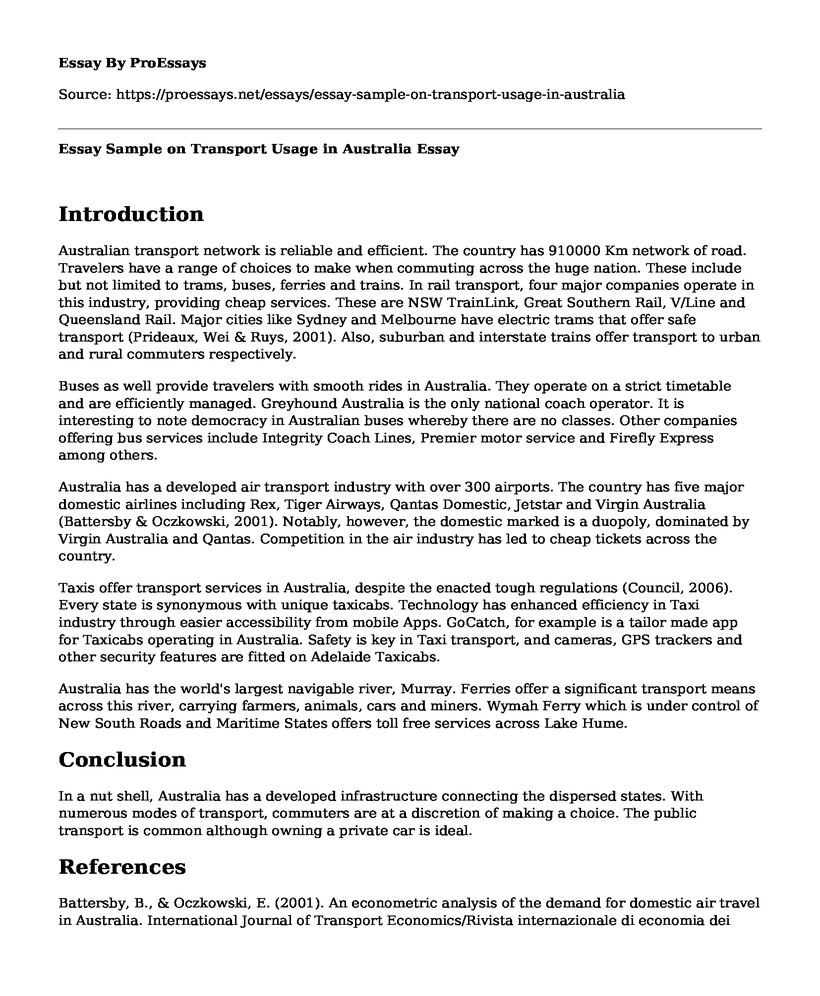Introduction
Australian transport network is reliable and efficient. The country has 910000 Km network of road. Travelers have a range of choices to make when commuting across the huge nation. These include but not limited to trams, buses, ferries and trains. In rail transport, four major companies operate in this industry, providing cheap services. These are NSW TrainLink, Great Southern Rail, V/Line and Queensland Rail. Major cities like Sydney and Melbourne have electric trams that offer safe transport (Prideaux, Wei & Ruys, 2001). Also, suburban and interstate trains offer transport to urban and rural commuters respectively.
Buses as well provide travelers with smooth rides in Australia. They operate on a strict timetable and are efficiently managed. Greyhound Australia is the only national coach operator. It is interesting to note democracy in Australian buses whereby there are no classes. Other companies offering bus services include Integrity Coach Lines, Premier motor service and Firefly Express among others.
Australia has a developed air transport industry with over 300 airports. The country has five major domestic airlines including Rex, Tiger Airways, Qantas Domestic, Jetstar and Virgin Australia (Battersby & Oczkowski, 2001). Notably, however, the domestic marked is a duopoly, dominated by Virgin Australia and Qantas. Competition in the air industry has led to cheap tickets across the country.
Taxis offer transport services in Australia, despite the enacted tough regulations (Council, 2006). Every state is synonymous with unique taxicabs. Technology has enhanced efficiency in Taxi industry through easier accessibility from mobile Apps. GoCatch, for example is a tailor made app for Taxicabs operating in Australia. Safety is key in Taxi transport, and cameras, GPS trackers and other security features are fitted on Adelaide Taxicabs.
Australia has the world's largest navigable river, Murray. Ferries offer a significant transport means across this river, carrying farmers, animals, cars and miners. Wymah Ferry which is under control of New South Roads and Maritime States offers toll free services across Lake Hume.
Conclusion
In a nut shell, Australia has a developed infrastructure connecting the dispersed states. With numerous modes of transport, commuters are at a discretion of making a choice. The public transport is common although owning a private car is ideal.
References
Battersby, B., & Oczkowski, E. (2001). An econometric analysis of the demand for domestic air travel in Australia. International Journal of Transport Economics/Rivista internazionale di economia dei trasporti, 193-204.
http://www.jstor.org/stable/42747595Council, A. T. (2006). National guidelines for transport system management in Australia. Background material, 5.
https://scholar.google.com/scholar?cluster=12571740551349778533&hl=en&as_sdt=0,5&sciodt=0,5Prideaux, B., Wei, S., & Ruys, H. (2001). The senior drive tour market in Australia. Journal of Vacation Marketing, 7(3), 209-219.
http://journals.sagepub.com/doi/abs/10.1177/135676670100700302
Cite this page
Essay Sample on Transport Usage in Australia. (2022, May 12). Retrieved from https://proessays.net/essays/essay-sample-on-transport-usage-in-australia
If you are the original author of this essay and no longer wish to have it published on the ProEssays website, please click below to request its removal:
- Is NAFTA Beneficial or More Harmful to the United State Economy?
- Creating Native Habitats in Miami Essay Example
- Policies to Reduce Banking and Financial Crises Essay
- Public Policy and Manager Essay Example
- Immigration to America in the 21st Century Paper Example
- International Dimensions of African Conflict - Essay Sample
- The Founding Documents: The Interplay of the Declaration of Independence and the United States Constitution







